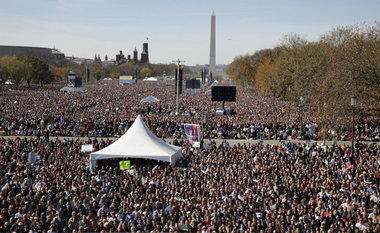Pope Francis not likely to get Stephen Colbert crowd-counting treatment

Thousands participate in the Rally to Restore Sanity and/or Fear on the National Mall in Washington, D.C., in 2010 during an event hosted by Stephen Colbert and Jon Stewart. (AP file photo)
A Virginia company that specializes in counting crowds at large events on the National Mall is modeling what the Benjamin Franklin Parkway will look like when hundreds of thousands of pilgrims flock there.
Digital Design and Imaging Service is building a 3-D computer model to show how the Parkway will fill up with different densities of people. It plans to release images to paying media companies about a week before the papal Mass on Sept. 27.
“One reason we’re making this tool is to help the public get educated so that they themselves, as they’re standing in line or watching this event, they can recall some of the imagery and make some estimates on their own,” said company president Curt Westergard.
For large events, the firm typically lifts a 360-degree camera array on a hot air balloon and compares photos to computer models to make accurate day-of attendance estimations.
It has done that for high-profile events such as the Glenn Beck and Stephen Colbert rallies near the U.S. Capitol in 2010, but Westergard said federal aviation authorities have preliminarily denied his airspace request for the pope’s visit.
Westergard said if his company can get the right access, it may still compare its computer models to photos taken on top of tall buildings or aerial TV footage to get a rougher estimate of crowd size.
The Falls Church, Virginia-based firm is currently discussing providing attendance estimates for the papal Mass on the Parkway for CBS News in Washington.
Crowd estimates can be contentious, and those making them often have a stake in how big or small the turnout is. The National Park Service came under fire for what was criticized as a low-ball count of the Million Man March in October of 1995 and subsequently stopped estimating attendance for events on the National Mall.
Digital Design and Imaging Service stepped in as an unbiased, third-party outfit that uses aerial imaging and computer modeling to more scientifically estimate crowd size within a margin of error.
Traditional crowd-counting methods estimate the number of people in a given section of the crowd, then multiply that figure by the number of sections the audience occupies.
Westergard’s company goes a step further by using different densities for different locations.
In areas close to a stage or TV screen, he guesses there will be one person per about 5 square feet.
“(That) would be where you’re actually elbow to elbow, and almost touching the people in front of you, very little personal space around you,” Westergard said.
Farther from the stage, his model allocates one person per 9 square feet or more.
“Which is like you’re standing in a 1-yard by 1-yard box,” Westergard said.
Densities tend to be lower behind trees that impede the view of the stage, but higher in the shade on hot days.
Westergard said he will not have an estimate of the total number of people the Parkway can hold until he ground-truths his computer models and gets more information.
“We’re building that model right now, trying to look at the total square footage, but we would then refine that once we know what the police are using for gates and security pinch points,” he said.
WHYY is your source for fact-based, in-depth journalism and information. As a nonprofit organization, we rely on financial support from readers like you. Please give today.

